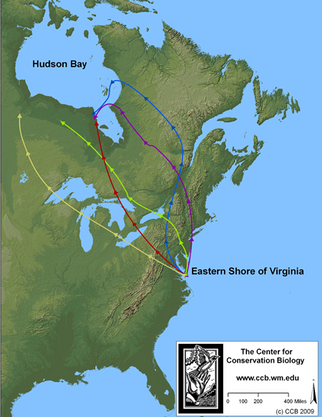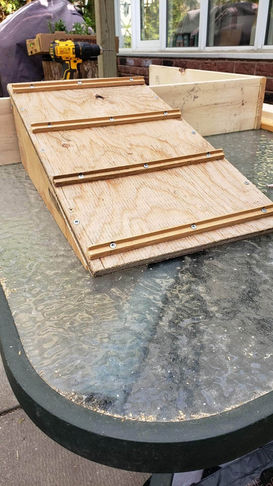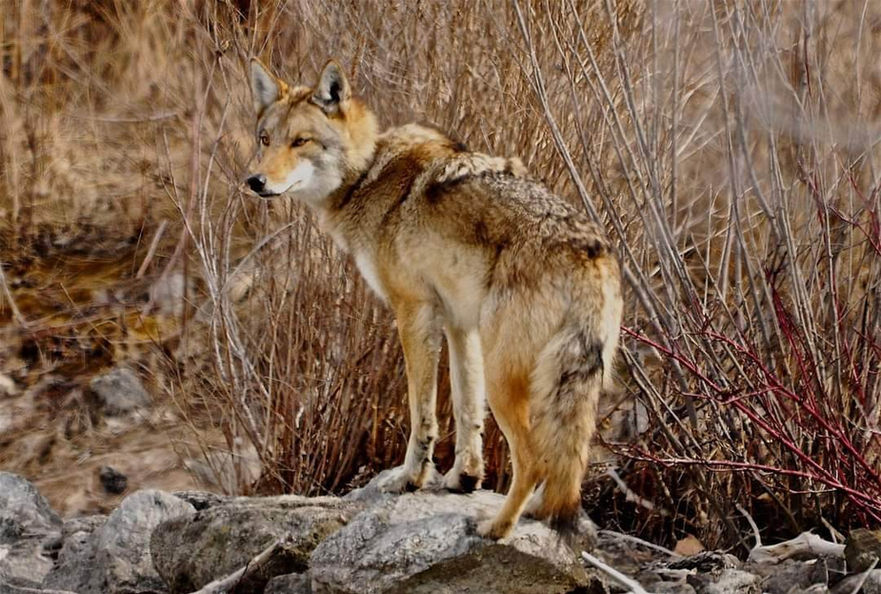Projects
Turtle Monitoring
Our inaugural Turtle Monitoring Project has been a success! This was our first season protecting Snapping Turtle nests and eggs around the North Creek Wetland and recruiting eager and interested volunteers to help observe each of the nest locations and report any progress to the organizers (Terry Smith, Duncan Farnan, Bruce Wilkinson, Nancy Barrett, Jasmin Patel, and all the other dedicated monitors who signed on for the season).
About 90 Snapping Turtle hatchlings from nests #3 and #4 have to date been successfully "escorted" to the water by FOSS turtle monitors. It looks like all of the eggs in nest #2 along the asphalt path were likely predated, probably by the skunks living close to that location who were able to dig under the frame. The nest protector that disappeared from nest #3 has turned up. It was retrieved November 3rd from the shore of the wetland pond island. How it got there is anyone's guess! That leaves nest #1. No turtle hatch was ever observed. We have removed the vegetation from the inside of the protector so that we can more easily observe. We are advised by the High Park Turtle Protectors that Snapping Turtle eggs, unlike Midland Painted, cannot survive the winter. They freeze solid and become unviable. Painted Turtle eggs, on the other hand, can freeze without cell damage and hatchlings can emerge the following spring. We are very much looking forward to a new season and our upcoming collaboration with the High Park Turtle Protection group!

Photo by Adam Solomon

Photo by Nancy Barrett

Photo by Adam Solomon


Photo by Nancy Barrett




Here are some stats from a 2018 survey that included Sam Smith:
-
the highest density of painted turtles amongst the Lake's coastal wetlands is Sam Smith. Not bad for a 5 ha - hectare park
-
we don't have an estimate for the Park snapping turtle population; the researchers were only able to trap 2 but we know of at least 4!
Winter Bird Feeder Project
The FOSS Winter Bird Feeder Project started in 2015, and has continued every year since then. Its purpose is to make life a little easier for the birds in the winter, and let park visitors see the local birds more easily. FOSS volunteers set up 5 bird feeding stations around the Colonel Sam Skating Trail in early December, and the project continues till the Skating Trail shuts down in mid March.
Each feeding station consists of a black oil sunflower feeder and a suet feeder. Urban Nature Store very generously donates to FOSS a large bag of black oil sunflower seed for every bag we purchase from them. This is a great help to this project- thank you Urban Nature Store!
Then we recruit 7 FOSS volunteers- one for each day of the week- to check on and fill the feeders from December to March. Sometimes a whole family takes on a day. Some of our volunteers have been with us for several years!
Right now we are urgently seeking volunteers to help with this project. If you are interested in volunteering for FOSS in this way, please contact Barbara.keaveney@sympatico.ca.
Click on images for captions.
Planting
Over the years the Friends of Sam Smith Park, with the help of volunteers from the public, has been involved in several plantings of native species in different areas of the park. These are always done with the help and supervision of The Parks department of the City of Toronto or the TRCA.
One of the ongoing projects is the planting of pollinators on the east side of the park. The other is of growing native bushes at Whimbrel Point to replace the invasive Common Burdock that had been removed.
We are looking forward to more plantings in order to reclaim some of the overused areas.
If you'd like to help with planting, please reach out to us!




Whimbrel Watch
May 20th to 30th, annually
Come join us in a celebration of these rare magnificent migrants as thousands journey to their breeding grounds on Hudson’s Bay and beyond.
Whimbrels are mega-shorebirds that have been known to pass Sam Smith Park in flocks totaling 10,000 birds. They are often heard before seen and their cry is haunting and unforgettable. Whimbrel Point, at the south-east corner of the spit, is one of the best spots in Canada to view their passage and birders and photographers gather to keep count of the population and hope for an occasional group to land. Whimbrels are only part of the magic. Many other gangs of shorebirds and water birds are on record passing the Point, including rarely seen white pelicans, black terns and Pacific loons.
This eastern population of whimbrels were recorded during the Civil War to number in the millions on the Carolina seashore. The group now numbers around 40,000 birds and is at risk. Our flocks fly from feasting on crabs in Virginia, travel nine hours through the night, and arrive on Lake Ontario in the morning. Sam Smith Park is one of the only places in the East to be situated on their pathway to the north. Not to be missed, this is one of nature’s spectacles.
To participate in the Whimbrel Watch reach out to us!
Click on images for captions.
Tree Swallows arrive early from their winter vacation in the southern states and Central America. They start turning up in the last week of March and are present in the park in large numbers by the middle of April.
The best place to see them in spring is in the Swallow Field. It is located south of the waterfront trail that runs through the park and immediately east of the yacht club. Friends of Sam Smith Park has been installing Tree Swallow nest boxes there over the past ten years. There are now more than sixty in the park. Every spring, volunteers prepare the boxes for the swallows by cleaning them out, repairing and sterilizing them against parasites.
Tree Swallows are declining in number because of increasing insect scarcity caused by the overuse of pesticides, climate change and pollution. Their preferred natural nesting spot is a cavity in an old tree, like a woodpecker hole, but, because of the removal of old trees and wetland drainage where old snags are commonly found, those spots are getting scarcer. So, the nesting boxes definitely help fill a need.
To date, FOSS estimates that well over a thousand young swallows have been raised in that field over the years and that could explain why we see ever increasing numbers each breeding season.
To help volunteer with the upkeep of the Swallow Field please contact us!
Click on images for captions.
The Swallow Field
Park Clean-Up
Our annual park clean-up blitzes, usually held in April, help protect our precious urban green spaces by reducing the amount of garbage in the park and along the shoreline.
Garbage bags and water are supplied; draw prizes, giveaways and community service hours are available.
Park users are encouraged to pick up trash items they find and discard them in the waste receptacles any time they visit.


Spring Bird Festival
A celebration that’s for the birds takes place each May at Colonel Sam Smith Park. With 292 documented species observed, the park ranks as the second most important birding area in Toronto. A star attraction of the festival is the passage of up to one quarter of North America’s population of Whimbrels as they make their way to their northern nesting grounds.
The Bird Festival is held during peak migration time with the aim of promoting an interest in birds as well as the protection of their natural nesting and safe resting habitats. It is a family friendly event and offers hourly guided bird walks, live bird and reptile demonstrations, photo displays, nature talks, children’s activities and workshops that feature the building of bird houses and feeders. Admission is free.
Click on images for captions.
Red-Necked Grebe Platforms
FOSS President Brian Keaveney and his family, along with welcome assistance from the Lakeshore Yacht Club, have been building and maintaining a number floating nesting platforms to provide Red-necked Grebes with safe, accessible nesting sites.
In April 2021, three new platforms and one refurbished platform were installed and immediately occupied by grebe pairs. Ramps have now been added to the platforms, allowing the parents and chicks easier access to the nest.
Click on images for captions.
Photo Exhibition
In an effort to engage and inspire community members, FOSS mounts juried photography exhibitions at the Assembly Hall to celebrate the diversity of wildlife and beauty of the natural landscapes in the park.
All skill levels are welcome. Winners are announced at the opening reception and prizes presented. In the winter of 2020-2021, we pivoted due to the pandemic and hosted a popular Winter Photo Contest in our Facebook group.
Click on images for captions.
"The Wildwood" Biodiversity Study
Friends of Sam Smith Park plans to conduct an inventory of the flora and fauna found in an area of the park which we are calling “The Wildwood”. The area lies between the two schools immediately south of the path that connects the two Humber College campuses and on the west side of Colonel Samuel Smith Drive.
We have chosen to do this study in the hope that the knowledge gained will help counteract any potential threat of development in the future to this remaining untouched patch of the former hospital’s grounds. It contains no paths, is seldom visited and, for those nature lovers with long memories, was and is always a joy and surprise to enter.
FOSS would like it to remain as it is and be forever undisturbed.
We are asking all you citizen scientists out there to help us.
We would like you to submit field observations of birds seen in this area through eBird and plant observations through iNaturalist, record-keeping platforms that will already be familiar to many of you.
Mammal, reptile, amphibian, bee, insect, spider, butterfly observations etc. can be sent via email to FOSS if you are confident about the accuracy of your observation. You will need to include the date and time of your observations. If you are able to get a good clear photograph, observations of the above can also be submitted through iNaturalist.
eBird and iNaturalist are both free apps that can be downloaded from Google Play for Android users and the App Store for Apple users. Alternatively, you can go straight to eBird.org and iNaturalist.org and set up a quick account.
When you have installed eBird and created an account, enter observations under “submit” and choose “Use latitude/Longitude”. The Latitude for The Wildwood is 43.596 and the longitude is -79.517.
When you have installed and created an account for iNaturalist, you will find a project area already created. Under “Projects”, use the search function to find "Wildwood Project – Colonel Samuel Smith" and enter your observations there.
Thank you for joining us on this.


![Screenshot_20220125-101125_eBird[5692].jpg](https://static.wixstatic.com/media/633bcd_a3623b6bdae64ef194c7f12e2f8cb5c5~mv2.jpg/v1/crop/x_0,y_0,w_1080,h_2081/fill/w_250,h_479,al_c,q_80,usm_0.66_1.00_0.01,enc_avif,quality_auto/Screenshot_20220125-101125_eBird%5B5692%5D.jpg)














































![#4[1846].jpg](https://static.wixstatic.com/media/af4200_5777951c342d4d6ba47bc395a2d12f8b~mv2.jpg/v1/fit/w_800,h_415,q_90,enc_avif,quality_auto/af4200_5777951c342d4d6ba47bc395a2d12f8b~mv2.jpg)



























